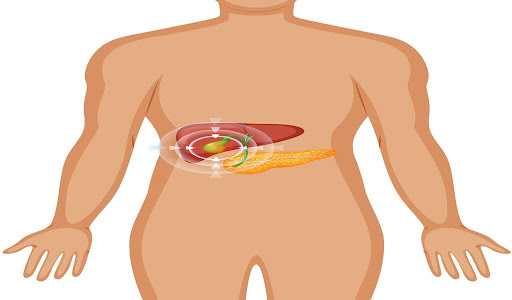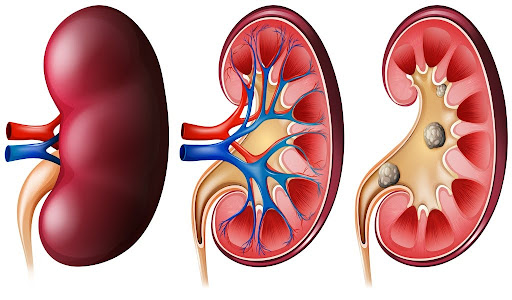Can Telehealth Prescribe Antibiotics for a UTI?
Urinary tract infections (UTIs) are among the most common bacterial infections, especially affecting women. They occur when bacteria enter the urinary system, causing [...]
Read More
Medically reviewed by Abhijit Bhattacharyya | MD, PhD, MBA, Tufts University School of Medicine - Miami, Florida on June 6th, 2025.
Gallstones and kidney stones are two common medical conditions that can cause significant discomfort and health complications. Despite their similar names, they are distinct entities with different causes, symptoms, and treatment options. Understanding the differences between gallstones and kidney stones can help individuals recognize their symptoms and seek appropriate medical attention when necessary.
 What Are Gallstones?
What Are Gallstones?Gallstones are hardened deposits that form in the gallbladder, a small organ located beneath the liver. The gallbladder stores bile, a digestive fluid produced by the liver that helps break down fats. When the balance of substances in bile is disrupted, solid particles can form and gradually develop into stones. These stones can vary in size, ranging from as small as a grain of sand to as large as a golf ball, and their formation can lead to various complications if left untreated.
Gallstones can be asymptomatic for long periods, but they can also lead to significant discomfort and health issues. In some cases, they may block the bile ducts, leading to a condition known as choledocholithiasis, which can cause severe pain and jaundice.
Understanding gallstones not only involves recognizing their formation but also appreciating their potential impact on digestive health and overall well-being.
There are two primary types of gallstones: cholesterol gallstones and pigment gallstones. Cholesterol gallstones are the most common, accounting for about 80% of cases. They are usually yellow-green in color and form when there is too much cholesterol in the bile. Factors such as rapid weight loss, certain medications, and metabolic disorders can increase the likelihood of cholesterol gallstone formation.
Pigment gallstones, on the other hand, are smaller and darker, resulting from excess bilirubin, a substance produced during the breakdown of red blood cells. These stones are more prevalent in individuals with liver cirrhosis, biliary tract infections, or hemolytic anemia, conditions that can elevate bilirubin levels in the body.
Several factors can contribute to the formation of gallstones, including:
Obesity: Excess body weight can increase cholesterol levels in bile.
Diet: A high-fat, high-cholesterol, and low-fiber diet may elevate the risk. Diets rich in refined carbohydrates and sugars can also contribute to gallstone formation.
Age: The likelihood of developing gallstones increases with age, particularly after the age of 40.
Gender: Women are more prone to gallstones, particularly during pregnancy or hormone therapy, due to the effects of estrogen on cholesterol levels.
Genetics: A family history of gallstones can increase risk, suggesting a hereditary component in gallstone formation.
Additionally, certain medical conditions, such as diabetes and liver disease, can further heighten the risk of developing gallstones. Understanding these risk factors is crucial for prevention and early intervention.
Many individuals with gallstones may not experience any symptoms, a condition known as "silent" gallstones.
However, when symptoms do occur, they may include:
Severe pain in the upper right abdomen
Pain between the shoulder blades
Pain in the right shoulder
Nausea or vomiting
Such symptoms often arise after consuming a fatty meal and may indicate a gallbladder attack or inflammation. In some cases, individuals may also experience bloating, indigestion, or changes in bowel habits. If these symptoms persist or worsen, it is essential to seek medical attention, as complications such as cholecystitis, pancreatitis, or even gallbladder cancer can arise from untreated gallstones.
 Kidney stones, also known as nephrolithiasis, are hard deposits made of minerals and salts that form inside the kidneys. They can vary in size, from tiny crystals to large stones that can block the urinary tract. The formation of kidney stones is often associated with high levels of certain substances in the urine.
Kidney stones, also known as nephrolithiasis, are hard deposits made of minerals and salts that form inside the kidneys. They can vary in size, from tiny crystals to large stones that can block the urinary tract. The formation of kidney stones is often associated with high levels of certain substances in the urine.
In many cases, these stones can pass through the urinary tract without causing significant issues, but larger stones may require medical intervention to remove them. Understanding the underlying mechanisms of kidney stone formation can help individuals take preventive measures to avoid this painful condition.
There are several types of kidney stones, categorized based on their composition:
Calcium Stones: The most common type, usually formed from calcium oxalate or calcium phosphate. These stones are often linked to dietary factors and can be influenced by the amount of oxalate-rich foods consumed, such as spinach and nuts.
Struvite Stones: Often associated with urinary tract infections, these stones can grow rapidly. They are typically composed of magnesium, ammonium, and phosphate, and can become quite large, sometimes requiring surgical removal.
Uric Acid Stones: Formed when urine is too acidic, often linked to certain diets and metabolic disorders. Individuals with high protein intake, particularly from animal sources, may be at greater risk for developing these types of stones.
Cystine Stones: Rare stones that occur due to a genetic disorder affecting amino acid absorption. These stones can be particularly challenging to manage, as they often recur despite treatment.
Kidney stones can develop due to various factors, including:
Dehydration: Insufficient fluid intake can lead to concentrated urine, increasing the risk of stone formation. Staying well-hydrated is one of the most effective ways to prevent kidney stones.
Diet: High sodium, protein, and sugar intake can contribute to stone development. Foods rich in oxalate, such as beets and chocolate, can also play a role in the formation of certain types of stones.
Obesity: Excess weight can alter the body's chemistry, promoting stone formation. Studies have shown that individuals with a higher body mass index (BMI) are at an increased risk of developing kidney stones.
Medical Conditions: Certain conditions, such as diabetes and hyperparathyroidism, can increase the likelihood of developing kidney stones. Additionally, a family history of kidney stones can also elevate one's risk.
Symptoms of kidney stones can be quite severe and may include:
Intense pain in the back, side, or lower abdomen
Pain during urination
Blood in the urine
Frequent urination or an urgent need to urinate
Nausea and vomiting
The pain associated with kidney stones is often described as one of the most intense experiences a person can endure. This pain, known as renal colic, typically comes in waves and can be accompanied by discomfort in the lower back or groin. Many individuals report that the pain can be so severe that it leads to restlessness and an inability to find a comfortable position. In some cases, the presence of kidney stones may also lead to urinary tract infections, which can further complicate symptoms and require additional medical attention.
While both gallstones and kidney stones can cause severe pain and discomfort, they differ significantly in their origins, symptoms, and treatment approaches. Below is a comparative analysis of the two conditions.
Location
Gallstones: Gallbladder
Kidney Stones: Kidneys
Formation
Gallstones: Hardened deposits of bile components
Kidney Stones: Mineral and salt deposits in urine
The symptoms of gallstones and kidney stones can overlap, but they also have distinct characteristics. Gallstones typically cause pain in the upper right abdomen, while kidney stones often result in pain that radiates from the back to the lower abdomen.
Diagnosis for both conditions may involve imaging tests such as ultrasound or CT scans, along with urine tests to assess composition. In the case of gallstones, patients may also experience nausea, vomiting, and jaundice if a stone blocks the bile duct. Kidney stones, on the other hand, can lead to hematuria, or blood in the urine, which is a critical indicator that prompts further investigation.
Treatment strategies for gallstones and kidney stones vary significantly:
Gallstones: Treatment may involve dietary changes, medication to dissolve stones, or surgery (cholecystectomy) to remove the gallbladder in severe cases.
Kidney Stones: Treatment options include increased fluid intake, pain management, and in some cases, procedures like lithotripsy to break up stones or surgical removal.
In addition to these standard treatments, lifestyle modifications play a crucial role in preventing the recurrence of both conditions.
For gallstones, a diet low in saturated fats and high in fiber can help reduce the risk of stone formation. Incorporating healthy fats, such as those found in olive oil, and maintaining a balanced diet can also support gallbladder health.
For kidney stones, staying well-hydrated is paramount; drinking plenty of water can dilute the substances in urine that lead to stone formation.
Furthermore, dietary adjustments, such as reducing oxalate-rich foods for those prone to calcium oxalate stones, can significantly decrease the likelihood of developing new stones.
Moreover, understanding the risk factors associated with each condition can empower individuals to take proactive measures. For instance, gallstones are more prevalent in individuals who are overweight, pregnant, or have a family history of the condition. Conversely, kidney stones are often linked to factors such as dehydration, certain metabolic disorders, and dietary habits high in sodium and animal protein. By recognizing these risk factors, individuals can make informed choices that may help mitigate their chances of experiencing these painful conditions.
Preventing gallstones and kidney stones involves lifestyle modifications and dietary considerations. Here are some strategies for each condition:
Maintain a Healthy Weight: Gradual weight loss can reduce the risk of gallstones.
Eat a Balanced Diet: Incorporate high-fiber foods, healthy fats, and limit refined carbohydrates.
Stay Hydrated: Adequate fluid intake can help maintain bile balance.
In addition to these strategies, regular physical activity is essential in preventing gallstones. Engaging in moderate exercise not only aids in weight management but also promotes overall digestive health. Activities such as walking, swimming, or cycling can stimulate the gallbladder, helping to prevent the buildup of substances that may lead to stone formation.
Furthermore, incorporating foods rich in omega-3 fatty acids, such as fatty fish, flaxseeds, and walnuts, can enhance gallbladder function and support a healthy lipid profile.
Stay Hydrated: Drink plenty of water to dilute urine and prevent stone formation.
Limit Sodium Intake: Reducing salt in the diet can decrease calcium excretion in urine.
Moderate Protein Consumption: Balance animal protein intake to reduce uric acid levels.
Moreover, understanding the specific types of kidney stones can further tailor prevention strategies. For instance, individuals prone to calcium oxalate stones may benefit from consuming foods high in calcium, such as dairy products, which can bind oxalate in the intestines and reduce its absorption.
On the other hand, those susceptible to uric acid stones might find it helpful to limit foods rich in purines, such as red meat and shellfish, while increasing their intake of fruits and vegetables that can help alkalinize the urine. Regular monitoring of dietary habits and consulting with a healthcare professional can provide personalized recommendations to effectively manage and prevent kidney stone formation.
 Recognizing when to seek medical help is crucial for both gallstones and kidney stones. Immediate medical attention is warranted if an individual experiences:
Recognizing when to seek medical help is crucial for both gallstones and kidney stones. Immediate medical attention is warranted if an individual experiences:
Severe abdominal or back pain that does not subside
Persistent nausea or vomiting
Fever and chills, which may indicate infection
Blood in urine or stool
Timely intervention can prevent complications and improve outcomes for both conditions. It is important to understand that while some symptoms may seem mild initially, they can escalate quickly. For instance, the pain associated with gallstones can often mimic that of a heart attack, leading to confusion and delay in treatment.
Similarly, kidney stones can cause excruciating pain that radiates from the lower back to the abdomen and groin, making it essential to seek help as soon as these symptoms arise.
In addition to the physical symptoms, individuals should also be aware of any changes in their overall health status. If you notice a sudden change in appetite, unexplained weight loss, or increasing fatigue, these could be signs that your body is under stress due to underlying issues related to gallstones or kidney stones. Early diagnosis and treatment can significantly impact recovery time and overall health, so don’t hesitate to reach out to a healthcare professional if you have any concerns.
While both gallstones and kidney stones are painful and disruptive, they are fundamentally different in their formation, symptoms, and treatment. Understanding these differences can empower individuals to make informed decisions about their health and seek appropriate care. By adopting preventive measures and recognizing symptoms early, it is possible to mitigate the risks associated with both conditions and improve overall well-being.
Don't let confusion keep you in the dark! Understanding the difference between gallstones and kidney stones with Doctronic, which will take charge of your health. Know the signs, seek the proper care, and make informed decisions to live pain-free and confidently.
Urinary tract infections (UTIs) are among the most common bacterial infections, especially affecting women. They occur when bacteria enter the urinary system, causing [...]
Read MoreManaging chronic conditions like type 2 diabetes and obesity can be challenging, but advances in medicine and technology are making treatment more accessible than ever. One [...]
Read MoreTelehealth has transformed the way people access healthcare by allowing patients to consult with medical professionals remotely, using digital platforms such as video calls, [...]
Read More